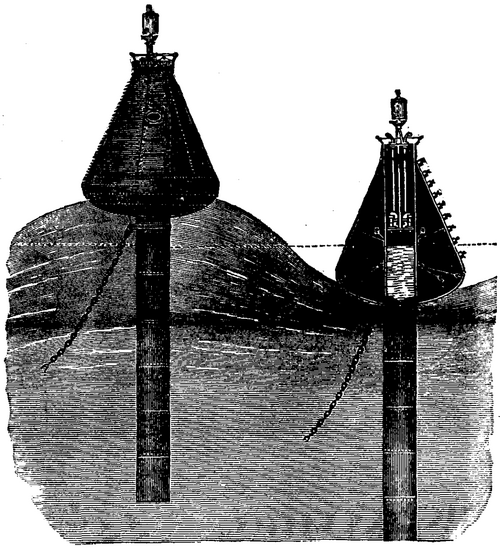The whistling buoy now in use was patented by Mr. J.M. Courtenay, of New York. It consists of an iron pear-shaped bulb, 12 feet across at its widest part, and floating 12 feet out of water. Inside the bulb is a tube 33 inches across, extending from the top through the bottom to a depth of 32 feet, into water free from wave motion. The tube is open at its lower end, but projects, air-tight, through the top of the bulb, and is closed with a plate having in it three holes, two for letting the air into the tube, and one between the others for letting the air out to work the 10-inch locomotive whistle with which it is surmounted. These holes are connected with three pipes which lead down to near the water level, where they pass through a diaphragm which divides the outer cylinder into two parts. The great bulb which buoys up the whole mass rises and falls with the motion of the waves, carrying the tube up and down with it, thus establishing a piston-and-cylinder movement, the water in the tube acting as an immovable piston, while the tube itself acts as a moving cylinder.
Thus the air admitted through valves, as the buoy rises on the wave, into that part of the bulb which is above water, is compressed, and as the buoy falls with the wave, it is further compressed and forced through a 2½ inch pipe which at its apex connects with the whistle. The dimensions of the whistling buoy have recently been much diminished without detracting materially from the volume of sound it produces. It is now made of four sizes. The smallest in our waters has a bulb 6 feet in diameter and a tube 10 feet in length, and weighs but 2,000 pounds. The largest and oldest whistling buoy has a 12-foot bulb, a tube 32 feet long, and weighs 12,000 pounds.

FIG. 1. - COURTENAY'S WHISTLING BUOY.
There are now 34 of these whistling buoys on the coast of the United States, which have cost, with their appurtenances, about $1,200 each. It is a curious fact that, in proportion as they are useful to the mariner, they are obnoxious to the house dweller within earshot of them, and that the Lighthouse Board has to weigh the petitions and remonstrances before setting these buoys off inhabited coasts. They can at times be heard 15 miles, and emit an inexpressibly mournful and saddening sound.
The inspector of the First Lighthouse District, Commander Picking, established a series of observations at all the light stations in the neighborhood of the buoys, giving the time of hearing it, the direction of the wind, and the state of the sea, from which it appears that in January, 1878, one of these buoys was heard every day at a station 1⅛ miles distant, every day but two at one 2¼ miles distant, 14 times at one 7½ miles distant, and 4 times at one 8½ miles distant. It is heard by the pilots of the New York and Boston steamers at a distance of one-fifth of a mile to 5 miles, and has been frequently heard at a distance of 9 miles, and even, under specially favorable circumstances, 15 miles.
The whistling buoy is also used to some extent in British, French, and German waters, with good results. The latest use to which it has been put in this country has been to place it off the shoals of Cape Hatteras, where a light ship was wanted but could not live, and where it does almost as well as a light ship would have done. It is well suited for such broken and turbulent waters, as the rougher the sea the louder its sound.
from Hacker News https://ift.tt/p0VsWKJ
No comments:
Post a Comment
Note: Only a member of this blog may post a comment.